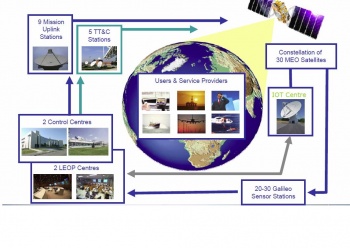If you wish to contribute or participate in the discussions about articles you are invited to contact the Editor
Galileo Architecture: Difference between revisions
No edit summary |
|||
| Line 22: | Line 22: | ||
* 5 Telemetry, Tracking and Control (TT&C) stations. | * 5 Telemetry, Tracking and Control (TT&C) stations. | ||
The Galileo Regional Component may comprise a number of External Region Integrity Systems (ERIS), implemented and operated by organisations, countries or groups of countries outside Europe to obtain integrity services independent of the Galileo System, in order, for example, to satisfy legal constraints relating to system guarantees. | The Galileo Regional Component may comprise a number of External Region Integrity Systems (ERIS), implemented and operated by organisations, countries or groups of countries outside Europe to obtain integrity services independent of the Galileo System, in order, for example, to satisfy legal constraints relating to system guarantees.<ref name="EsaGalileoweb"/> | ||
The Galileo Local components may be deployed for enhancing the performance of Galileo locally. These will enable higher performance such as the delivery of navigation signal in areas where the satellite signals cannot be received. Value-added service providers will deploy local components. | The Galileo Local components may be deployed for enhancing the performance of Galileo locally. These will enable higher performance such as the delivery of navigation signal in areas where the satellite signals cannot be received. Value-added service providers will deploy local components.<ref name="EsaGalileoweb"> | ||
==GALILEO Space Segment== | ==GALILEO Space Segment== | ||
Revision as of 14:08, 27 April 2011
| GALILEO | |
|---|---|
| Title | Galileo Architecture |
| Author(s) | GMV |
| Level | Basic |
| Year of Publication | 2011 |
The GALILEO System will comprise global, regional and local components. The global component is the core of the system, comprising the satellites and the required ground segment. To ensure GALILEO services, a specific architecture is deployed, that will consist of 30 satellites, to be deployed in a staggered approach, and the associated ground infrastructure.[1]
The Galileo system is divided into three major segments: Space Segment, Control Segment and User Segment.
Introduction
The Galileo global infrastructure, the core of the system, will be composed of [2]:
- A constellation of 30 satellites in Medium-Earth Orbit (MEO). Each satellite will contain a navigation payload and a search and rescue transponder;
- around 30 sensor stations (GSS);
- 2 Control Centres & 2 Launch Early Operations (LEOP) Centers;
- 9 Mission Uplink stations;
- 5 Telemetry, Tracking and Control (TT&C) stations.
The Galileo Regional Component may comprise a number of External Region Integrity Systems (ERIS), implemented and operated by organisations, countries or groups of countries outside Europe to obtain integrity services independent of the Galileo System, in order, for example, to satisfy legal constraints relating to system guarantees.[1]
The Galileo Local components may be deployed for enhancing the performance of Galileo locally. These will enable higher performance such as the delivery of navigation signal in areas where the satellite signals cannot be received. Value-added service providers will deploy local components.Cite error: Closing </ref> missing for <ref> tag At this stage, accuracy and availability will not yet have reached their optimum level, the Safety-of-Life Service and the Commercial Service will be tested and will be provided as the system reaches full operational capability with the 30 satellites.[3]
Highly accurate atomic clocks are installed on these satellites. Each of the 30 satellites in the Galileo system will have two of each type of clock on board, a rubidium and a hydrogen maser clock. The frequency is at around 6 GHz for the rubidium clock and at around 1.4 GHz for the hydrogen clock. The Galileo system uses the clock frequency as a very stable reference by which other units can generate the accurate signals that the Galileo satellites will broadcast. The broadcast signals will also provide a reference by which the less stable user receiver clocks can continuously reset their time.
GALILEO Ground Segment
The Galileo Control Segment (also referred to as Ground Segment) is the responsible for the proper operation of the GNSS system. Its basic functions are:
- To control and maintain the status and configuration of the satellite constellation.
- To predict ephemeris and satellite clock evolution.
- To keep the corresponding GNSS time scale (through atomic clocks).
- To update the navigation messages for all the satellites.
The Galileo Ground Segment constitutes the major system element controlling the entire constellation, the navigation system facilities and the dissemination services. It is composed of two Ground Control Centres (GCC), five Telemetry, Tracking and Control (TT&C) stations, nine Mission Uplink Stations (ULS), and about thirty Galileo Sensor Stations (GSS). The Ground Control Segment (GCS) as the responsible for satellite constellation control and management of Galileo satellites, provides the telemetry, telecommand and control function for the whole Galileo satellite constellation. Its functional elements are deployed within the GCCs and the five globally distributed TT&C stations.
GALILEO User Segment
The Galileo User Segment is composed by Galileo receivers. Their main function is to receive Galileo signals, determine pseudoranges (and other observables), and solve the navigation equations in order to obtain their coordinates and provide a very accurate time.
Three receiver development activities have been initiated within the Galileo programme, addressing the different needs of the system development process and covering the range of signals and services that will be offered. Activities in receiver development are in the following areas:[1]
- test user segment.
- receivers for the signals transmitted by the first experimental satellites.
- receivers for the Galileo receiver chain.
Notes
References
- ^ a b c ESA Galileo web page
- ^ J. Sanz Subirana, JM. Juan Zornoza and M. Hernández-Pajares, Global Navigation Satellite Systems: Volume I: Fundamentals and Algorithms
- ^ Mid-term review of the European satellite radio navigation programmes


